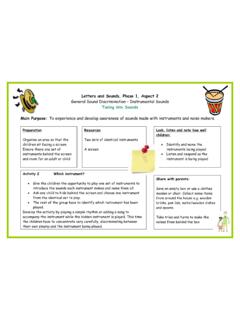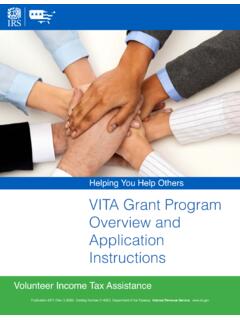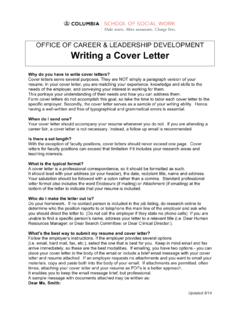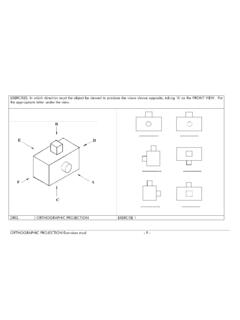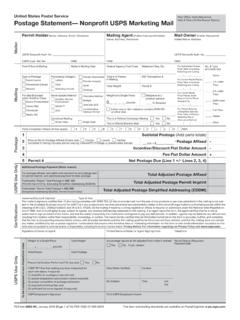Transcription of Letters and Sounds - Phase 1 Aspect 4
1 Letters and Sounds - Phase 1 Aspect 4 Rhythm and Rhyme Tuning into Sounds Main purpose: To experience and appreciate rhythm and rhyme and to develop awareness of rhythm and rhyme in speech Preparation Consider how you can use the room to your advantage. If you can split the children up into smaller groups the session will be more intimate and enable practitioners to understand and support the development needs of each child. Take advantage, man the book area at every opportunity. Look, listen and note how well children: Understand the pattern of syllables in the words presented to them Sing or chant the rhyming string along with the adult Recognise that the words rhyme Join in with simple or complex rhythms Copy the rhythm Keep to the beat Resources A selection of stories, which contain a rhyming text.
2 Activity 1: Rhyming books Regularly include rhyming books as part of the daily book sharing session. Read these books with plenty of intonation and expression so that the children tune into the rhythm of the language and the rhyming words. Encourage the children to join in with repetitive phrases such as Run, run as fast as fast as you can, You can t catch me, I m the Gingerbread man. Wherever possible make the activity multi-sensory to intensify learning and enjoyment. Share with Parents Actively encourage parent helpers. A book loan service would enable children and parents to access rhyming texts. Letters and Sounds - Phase 1 Aspect 4 Rhythm and Rhyme Tuning into Sounds Main purpose: To experience and appreciate rhythm and rhyme and to develop awareness of rhythm and rhyme in speech Preparation None required Look, listen and note how well children: Understand the pattern of syllables in the words presented to them Sing or chant the rhyming string along with the adult Recognise that the words rhyme Join in with simple or complex rhythms Copy the rhythm Keep to the beat Resources None required Activity 2.
3 Learning songs and rhymes Make sure that singing and rhyming activities are part of the daily routine in a small-group time and that extracts are repeated incidentally as events occur ( It s raining, it s pouring as the children get ready to go outdoors in wet weather). Play with rhyming words throughout the course of the day and have fun with them. Sing or chant nursery rhymes and encourage the children to move in an appropriate way ( rock gently to the beat of See Saw Marjorie Daw, march to the beat of Tom, Tom the Piper s Son and the The Grand Old Duke of York, skip to the beat of Here we go round the Mulberry Bush ). Share with Parents It would be very difficult to inform parents of incidental songs, however the children will support this because they will begin to sing at appropriate times when going out in the rain, if they see a bird sitting on a wall, on the see-saw in the park.
4 Letters and Sounds - Phase 1 Aspect 4 Rhythm and Rhyme Tuning into Sounds Main purpose: To experience and appreciate rhythm and rhyme and to develop awareness of rhythm and rhyme in speech Preparation Look, listen and note how well children: Understand the pattern of syllables in the words presented to them Sing or chant the rhyming string along with the adult Recognise that the words rhyme Join in with simple or complex rhythms Copy the rhythm Keep to the beat Resources Book or file to add to. Bag or box to add items too, a bus, frogs, ducks, star, spider, bucket. Activity 3: Our favourite rhymes Support a group of children to compile a book of their favourite rhymes and songs. They could represent the rhymes in any way they choose.
5 The book can be used to make choices about which rhyme to say during singing time, or used for making independent choices in the book corner. Children may choose to act as teacher selecting rhymes for others to perform, individually or as a group. Have a bag of objects which represent rhymes and invite the children to choose their favourite. Share with Parents Ensure parents can access the book Letters and Sounds - Phase 1 Aspect 4 Rhythm and Rhyme Tuning into Sounds Main purpose: To experience and appreciate rhythm and rhyme and to develop awareness of rhythm and rhyme in speech Preparation A quiet area with space for a circle of children Collect a selection of rhyming objects cat, hat, bat, mat or fox, box, socks.
6 Look, listen and note how well children: Sing or chant the rhyming string along with the adult Recognise that the words rhyme Resources Bowl Wooden spoon Selection of rhyming objects Activity 4: Rhyming soup (see appendix 2) Ask a small group of children to sit in a circle so they can see a selection of rhyming objects placed on the floor Use a bowl and spoon as props to act out the song Invite the children, in turn to choose an object to put in the soup and place in the bowl After each turn, stir the soup and sing the following song to the tune of Pop, goes the Weasel to recite the growing list of things that end up in the soup. I m making lots of silly soup, I m making soup that s silly, I m going to cook it in the fridge, To make it nice and chilly.
7 In Share with Parents Parents can play a game of rhyming I spy. I spy with my little eye. Something that rhymes with Letters and Sounds - Phase 1 Aspect 4 Rhythm and Rhyme Tuning into Sounds Main purpose: To experience and appreciate rhythm and rhyme and to develop awareness of rhythm and rhyme in speech Preparation An extra member of staff may be useful to support this activity as the children are required to give and take from each other. Look, listen and note how well children: Sing or chant the rhyming string along with the adult Recognise that the words rhyme Resources Set of rhyming pictures Drawstring bag Objects or pictures, which rhyme Activity 5: Rhyming bingo Give each child in a small group a set of three pictures of objects with rhyming names (available commercially).
8 Hide in a bag a set of pictures or objects matching the pictures you have given to the children. The children take turns to draw out of the bag one object or picture at a time. Invite the children to call out when they see an object or picture that rhymes with theirs and to collect it from the child who has drawn it out of the bag After each rhyming set is completed chant together and list the rhyming names. As you name objects give emphasis to the rhyming pattern Share with Parents Parents can play a game of rhyming I spy. I spy with my little eye. Something that rhymes with Letters and Sounds - Phase 1 Aspect 4 Rhythm and Rhyme Listening and Remembering Sounds Main purpose: To increase awareness of words that rhyme and to develop knowledge about rhyme Preparation Children need to be familiar with the rhyming word families before they can use them in a game spend time looking at the pictures and talking about the pairs.
9 Look, listen and note how well children: Recognise rhyming words Listen and attend to the rhyming strings Resources Pictures of objects that rhyme Activity 6: Rhyming pairs In a pairs game, use pictures of objects with names that rhyme The children take it in turns to turn two cards over and keep them if the pictures are a rhyming pair If they are not a rhyming pair the cards are turned face down again and the next person has a turn. Start with a small core set of words that can then be extended Share with Parents The I spy game explained in Activity 5 Share with parents column is still relevant. Letters and Sounds - Phase 1 Aspect 4 Rhythm and Rhyme Listening and Remembering Sounds Main purpose: To increase awareness of words that rhyme and to develop knowledge about rhyme Preparation Look, listen and note how well children: Recognise rhyming words Listen and attend to the rhyming strings Resources Nursery rhyme books Books with rhyming texts Activity 7: Songs and rhymes Include a selection of songs within the daily singing session, which involve children in experimenting with their voices.
10 Simple nursery rhymes, such as Hickory,Dickory Dock provide an opportunity for children to join in with wheeeee as the mouse falls down. Use this to find related words that rhyme: dock, clock, tick-tock. Substitute alternative rhyming Sounds to maintain children s interest and enjoyment. Finish the rhyme Use books with predictable rhymes that children are familiar with and stop as you come to the final word in the rhyme. Invite children to complete it. Use plenty of intonation and expression as the story or rhyme is recounted. Share with Parents Inform of any new rhymes Make up appropriate rhymes to go with a task Rub-a-dub-dub Give the dolly a scrub We re off to the shop With a hop, hop, hop. Letters and Sounds - Phase 1 Aspect 4 Rhythm and Rhyme Talking about Sounds Main purpose: To talk about words that rhyme and to produce rhyming words Preparation Prepare yourself by thinking of names for your puppets to ensure you can make up rhyming strings with the children Look, listen and note how well children: Generate their own rhymes Complete sentences using appropriate rhyming words Make a series of words that rhyme Resources Puppets or soft toys Activity 8: Rhyming puppets Make up silly rhyming names for a pair of puppets ( Fizzy, Wizzy Lizzy and Hob Tob Bob).
